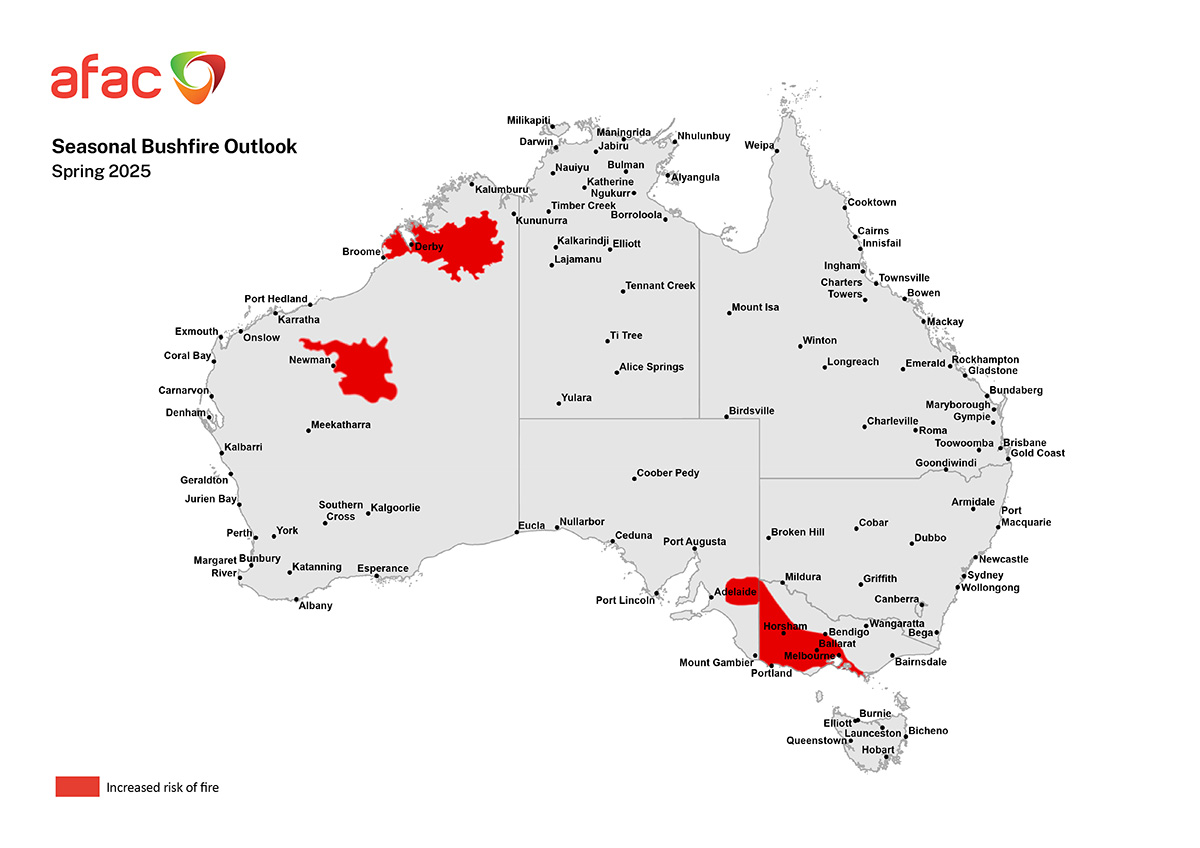Seasonal Bushfire Outlook Spring 2025
The Seasonal Bushfire Outlook for spring 2025 identifies a heightened risk of fire for the Dampier Peninsula, Derby Coast and parts of the Kimberley, Pilbara and Little Sandy Desert regions in Western Australia.
Fire Commissioners and Chiefs today released AFAC’s Seasonal Bushfire Outlook for spring. Despite large parts of the country more likely to receive wetter than normal conditions, there remain parts of the east and west where there remains a heightened risk of fire.
The Outlook for spring 2025 identifies a heightened risk of fire for the Dampier Peninsula, Derby Coast and the Central Kimberley, Little Sandy Desert, and south-eastern Pilbara in Western Australia, the south-eastern agricultural areas of the Murraylands in South Australia, and the south, southwest, central, and southwest Gippsland regions in Victoria.
The higher risk of fire in WA follows increased fuel growth following seasonal rains, coupled with the predicted warmer than normal temperatures and higher likelihood of below average rainfall through spring.
Towards the southeast of Australia, surface moisture hides deeper drying that has resulted from long term rainfall deficiencies that have built over the last 12-18 months. Some places have reported their lowest ever rainfall during this period. If spring rainfall doesn’t eventuate, the conditions will rapidly switch to an increased risk of fire.

AFAC CEO Rob Webb said: “No matter where you live or travel this season, everyone can play an important role in bushfire safety this spring by being prepared and staying alert to warnings and advice. Having a plan doesn’t take long and might just make the difference.”
"Local fire authorities will be monitoring bushfire risk this season so you can stay up to date and ready to act if there is an emergency.”
Communities are encouraged to be vigilant and stay alert this spring even if in areas of Australia showing normal risk of fire. Catastrophic fires can still occur during normal bushfire seasons.
The Bureau of Meteorology’s most up-to-date information has supported the outlook. They show long-term rainfall deficiencies persist in southern SA, Victoria and Tasmania, as well as western WA. In contrast, rainfall has been above to very much above average for northern WA, most of the NT, and Queensland.
Above average sea surface temperatures persist around much of the Australian coastline, providing increased moisture and energy that can enhance the severity of storms and weather systems.
The Bureau advises that September to November is more likely to experience above average daytime temperatures across northern, western, and south-eastern Australia, with overnight temperatures expected to be warmer nationwide. Soil moisture is average to above average for most parts of the country, however drier than average levels persist in small parts of western and southern WA, Southern NSW, central Victoria, and Tasmania.
The El Niño–Southern Oscillation is neutral, while the Indian Ocean Dipole is expected to reach a negative phase during spring.
This Seasonal Outlook was developed by AFAC, the Bureau of Meteorology, Queensland Fire Department, NSW Rural Fire Service, ACT Emergency Services Agency, ACT Parks and Conservation Service, Country Fire Authority, Department of Energy, Environment and Climate Action VIC, Tasmania Fire Service, SA Country Fire Service, Department of Fire and Emergency Services, Department of Biodiversity, Conservation and Attractions WA, and Bushfires NT.
Attachments:
ACT_Seasonal-Bushfire-Outlook_Spring-2025.jpg
AFAC-Seasonal-Bushfire-Outlook_Spring-2025_v1.0.pdf
AUS_Seasonal-Bushfire-Outlook_Spring-2025.jpg
NSW_Seasonal-Bushfire-Outlook_Spring-2025.jpg
NT_Seasonal-Bushfire-Outlook_Spring-2025.jpg
QLD_Seasonal-Bushfire-Outlook_Spring-2025.jpg
SA_Seasonal-Bushfire-Outlook_Spring-20256.jpg
TAS_Seasonal-Bushfire-Outlook_Spring-2025.jpg
VIC_Seasonal-Bushfire-Outlook_Spring-20258.jpg
WA_Seasonal-Bushfire-Outlook_Spring-20259.jpg